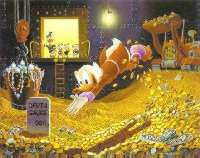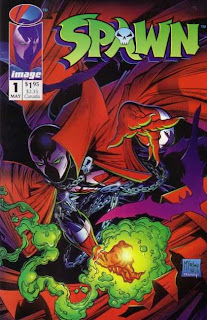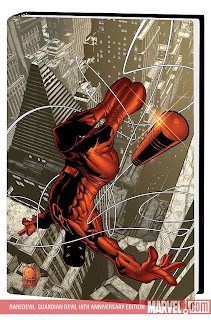And, being as how that was one of the main purposes of this blog, we felt that we should probably address that in the near future. So, in the coming weeks, both Nathaniel and I will be doing some of these big, honking, Exfanding-type posts.
I'll kick things off today (and, most likely, tomorrow) with a (long-winded) post about the whole "collectibility" of comics, since that's something I haven't really talked about in depth.
I mean, sure, I've had some crazy rants about speculators and how variant covers are stupid, and how I have pretty much eliminated my "collector's mentality" when it comes to comics.
But that's not to say I don't have some (strong and sometimes insane) opinions on the current comics back issue marketplace. Now, when I say "back issue," I mean just that--issues from months and years past.
Obviously, the older a book is, the higher the possibility that it is rare and difficult to find. The reason older books--such as Golden Age DC comics and Silver age Marvels--are so expensive today has to do with the fact that there just aren't that many of them out there.
Taking that a step further, there are far less of those books in good condition. Why? Well, because back then, these things were just paper. There was nothing special about them. They were bought and sold for a nickel or a dime, rolled up, and carried in some kid's back pocket.
They were traded between friends, and read countless times, covers rolled back as they did so. Then, when the book got too rough condition-wise, or when the stories inside became boring...they were tossed in the trash.
Unsold copies of the books from newsstands had their covers slashed, and the overstock was sent back to the publishers. And even though the print runs on comics back then were in the millions each and every month, there just aren't many books that remain on the market today.
Conversely, the reason all of those Image books and copies of the "Death of Superman" issue you see lining the walls of your local comics shop as insulation are worthless today (aside from being used as insulation, I mean) is that they were printed in huge numbers, but they were sold to a customer base that was aware of the potential "collectibility" of each and every issue.
 The proprietor of my local shop once told me a story about certain customers he had in the 1990s. During the absolute peak of the 90s boom, he had to keep a hand truck up by the cash register. The store had people literally coming in each week, buying so many copies (of the same book, usually) that they needed the hand truck just to get the books to their cars.
The proprietor of my local shop once told me a story about certain customers he had in the 1990s. During the absolute peak of the 90s boom, he had to keep a hand truck up by the cash register. The store had people literally coming in each week, buying so many copies (of the same book, usually) that they needed the hand truck just to get the books to their cars.With the new found (and wholly false) notion that these books would pay for their children's education at some point down the road, or allow them to Scrooge McDuck it into a money bin, speculators flooded comics shops and did their best to destroy an entire industry.
 Of course, as is the case with all things in life, there are other villains in the story when Bad Things start happening.
Of course, as is the case with all things in life, there are other villains in the story when Bad Things start happening.In the case of the 90s boom and eventual bust, the comics companies themselves played their role quite well. Seeing that books were selling more and more, they printed more and more. Which, in and of itself, is just solid business practice, right? Sure. Except that they did so knowing full well that these books were going to be worthless.
Unlike the books printed in the Golden and Silver Ages, these "Modern" or "Copper Age" books were printed in massive quantities, and they weren't going to be thrown out any time soon, so the chances of them ever being "rare" were (and still are) slim-to-none.
It's the rarity that makes something collectible, of course.
So, fine. At first, it's entirely possible that Marvel and DC and Image saw the number of books they were selling, and went, "holy cow, we need to print more--people love our books!" Very soon, though, it became crystal clear that, while more books were being purchased, they were being purchased by approximately the same number of people that were buying books earlier in the decade.
Sure, there were new "fans" coming in--but not many. And most certainly not fans.
Now, the companies clearly knew this fairly early into the boom, because there were retailers (like Brian Hibbs, owner of San Fran's legendary Comix Experience store) who were screaming and yelling at the top of their lungs that the fan base itself wasn't growing--it was the speculator market that was growing.
Still, one can argue that the big companies were just trying to make a buck off a fanbase that was kinda stupid. Capitalism at its finest, yes? Well, sure, until the companies took things even a step further. When they saw that people would buy doubles of books--one to read, one to stash away for future monetary gain--the companies decided to take full advantage.
Enter the variant cover.
Why sell a million copies of Spawn, issue one, when you can sell five million copies of X-Men, issue one, if there are five different covers? People will buy them all! It'll be great! We're awesome!
 I've heard interviews with guys from Marvel at the time, claiming that they thought demand was so high because there were so many new readers.
I've heard interviews with guys from Marvel at the time, claiming that they thought demand was so high because there were so many new readers.Right. And Jean Grey is going to stay dead this time.
Finally, when people started trying to sell off their "hot" issues a couple of years down the road...no one wanted them.
Because everyone already had them.
And they had twenty copies of them. Some still in the polybag they came in, never touched by human hands and in mint condition. That's great and all, but I can have an absolute, gem mint condition one dollar bill from three years ago.
Can you guess what it's worth today?
And so the speculators all got out of the industry. But they brought many real fans with them. People who had bought comics for decades had done so because they wanted to read about the characters they loved.
They didn't care about a holofoil cover to X-Factor, issue ten, and they didn't care about the first appearance of a character that was created for the express purpose of making an issue collectible. So they bolted. They headed for the doors and never came back.
When the 90s boom turned into the 90s bust, comics were left in a state of great uncertainty. Marvel had to file for bankruptcy, and there were less readers than ever before in the industry.
Image had gone from this greatly anticipated start-up company to this great beast, mired by late books and sub-standard stories. It wasn't until Joe Quesada took over Marvel's Knights line that things started to turn around a bit. And it was a Kevin Smith-penned and Quesada-drawn run on a relaunched Daredevil series that gave the industry a real kick start and a kick in the direction of legitimacy.
 When he took over as Editor-in-Chief of the publisher, Quesada brought with him the next wave of great comics writers. Brian Bendis and Mark Millar became household names, and they were followed by the likes of Ed Brubaker and Warren Ellis and Joss Whedon.
When he took over as Editor-in-Chief of the publisher, Quesada brought with him the next wave of great comics writers. Brian Bendis and Mark Millar became household names, and they were followed by the likes of Ed Brubaker and Warren Ellis and Joss Whedon.And so comics started on the long road towards mainstream acceptance and slowly left the mess of the 90s behind. But, while new comics were experiencing a nice little renaissance, what was going on with the back issue market?
Well, as someone who got into comics in 2003 without so much as a catch net when it came to back issue collecting, I can tell you that older books always sell. The 90s stuff is typically referred to as "dreck" by both retailers and collectors, and even in the early 2000s, everyone knew those books would still be worthless today.
And we were all absolutely right, of course.
If you've ever spent any time in a comics shop on an even somewhat regular basis, you have no doubt been privy to a conversation between a comics shop employee and a customer who walks into the store with a box full of "old" comics that he "knows are worth a lot of money."
Ask any retailer, and they'll tell you that, whenever they get that call from a guy with "old" comics, they fully expect to find at least one copy of Spawn, issue one, in the box.
And then the customer comes into the store, with a box of books, and proceeds to spread out doubles and triples of some of the 90s most egregious offenders. Usually, situations like that end in one of two ways.
First, the owner of the shop will tell the customer that he already has way too many copies of each book in the box, just taking up space in his back issue bins and not selling at all.
Or second, he'll make an offer that is much lower--like, five or ten cents a book--than the customer anticipated. That exchange usually ends with, "You're just trying to take advantage of me. But I'll show you--I'll sell them on eBay." To which the retailer says, "good luck," and is just happy he didn't get punched.
What the customer in that scenario usually doesn't understand is...well, a lot of things, actually. Like the current (and volatile) comics market. And supply and demand.
Typically, the issues that are most highly sought after by collectors are number one issues of long-running series, or issues that feature the first appearance of a major character. For example, Batman, issue one, from 1939, is one of the most coveted comics in history.
 It comes up at auction--in any grade--and sells for a premium.
It comes up at auction--in any grade--and sells for a premium.But Batman's first appearance does not take place in that book. Instead, several months earlier, Bob Kane's most famous character appeared in the crime anthology book, Detective Comics, issue 27, in 1937.
And that book.
Well, that book goes for buy-your-own-private-jet-or-two prices. If you have a copy of one of those in the attic, and you need to...um...buy a house, I'd say now's a good time to sell it.
 Of course, the chances of you or me ever owning a copy (or, for that matter, holding one in our hands) is quite slim. But, there are other books out there--from each of the four comics "ages"--that are good values.
Of course, the chances of you or me ever owning a copy (or, for that matter, holding one in our hands) is quite slim. But, there are other books out there--from each of the four comics "ages"--that are good values.First, though--a quick crash course.
But that'll have to wait until tomorrow, because otherwise this post would be stupid long. So, be sure to come back here--same bat-time, same bat-channel--if today's missive hasn't managed to glue your eyes completely shut.

No comments:
Post a Comment